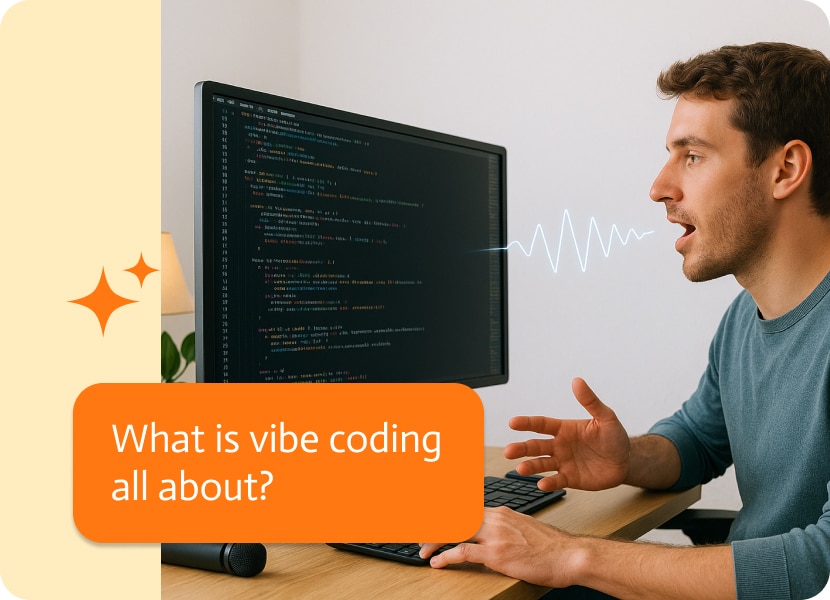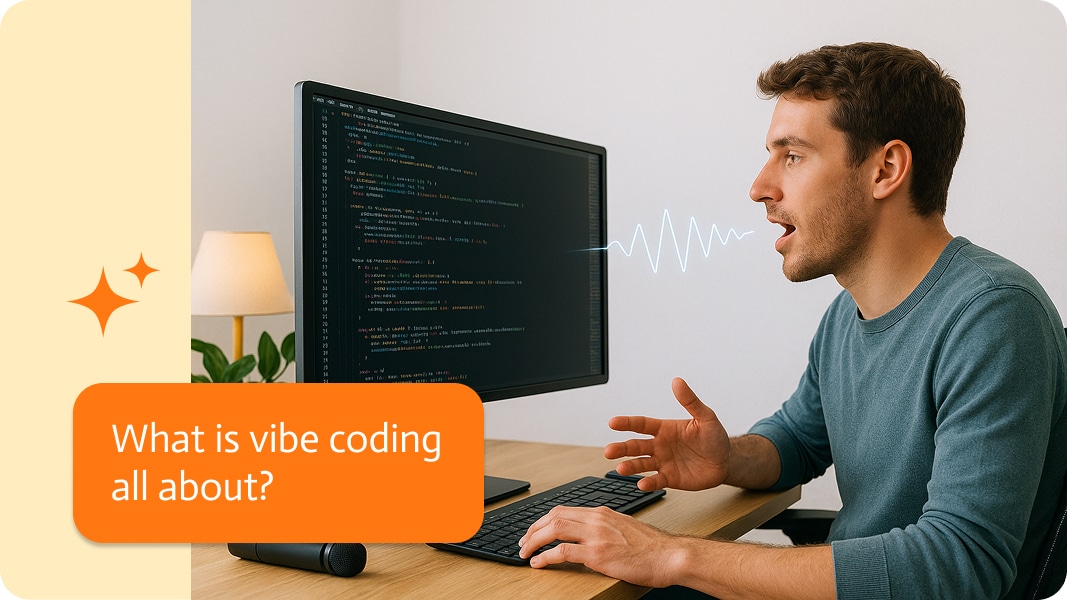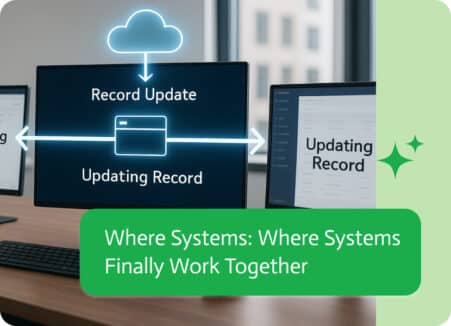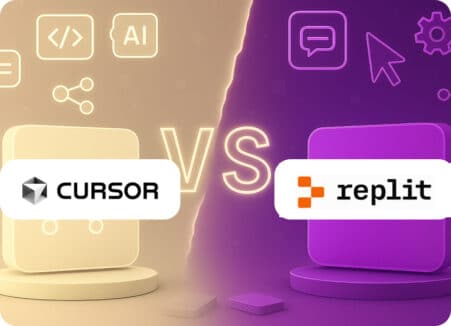

What is vibe coding all about?
It’s a whole new way to build software. The basic idea is to turn everyday thoughts, whether you type, say, or draw them, into code that works pretty much after the first try. Instead of writing every single line yourself, you just tell the system what you want your app, website, or process to do, and the system takes care of the hard stuff. Anyone can do it, even if you’re not a coder.
This isn’t just another simple drag-and-drop builder. Vibe coding gets what you’re trying to do and helps you try out different ideas quickly. It uses smart AI, previews that show you changes as they happen, and works with your favorite design tools. You can take a general idea, like a cool phone app for freelancers to keep track of payments, and turn it into a real, working app.
Think about it, you could chat with your computer like it’s your design buddy or sketch out a basic design and have working parts of your app ready to go right away; that’s vibe coding.
How Is Vibe Coding Changing the Future?
Accessibility Explosion
Vibe coding is opening the door to software development for just about everyone. You no longer need a computer science degree or years of experience to turn a great prompt to app idea into something real; a clear goal and a few friendly prompts are often all it takes. Entrepreneurs can whip up quick prototypes without hiring a full dev team. Designers can map a visual idea directly into working code while it’s still fresh in their heads. Even marketers and ops folks now spin out automated workflows or simple dashboards without waiting for IT.
By linking creative vision directly to technical output, vibe coding is changing who can join the digital economy-and that promises to redefine the future of work.
Speed & Agility
Building software used to take forever because developers had to set up servers, copy long blocks of boilerplate code, and hunt down bugs scattered everywhere. Vibe coding changes that. Everything from user log-ins to whole database structures can be spun up in minutes instead of days. Front-end screens, API hooks, and even the deployment files appear in real time as the team types. That kind of speed gives agility-startups can test ten ideas before lunch, and large companies switch direction the moment a new requirement lands.
Development cycles shrink so much that teams react to customers, markets, and fresh data much faster than old-school methods allow.
Human-AI Co-Creation
Instead of pushing engineers out of their own projects, vibe coding lifts them to a higher plane. It takes over the grind—setting up state logic, churning out another CRUD routine, and patching the same bug for the umpteenth time, and hands developers the bandwidth to think about architecture, optimization, security, and the daring features that spark excitement.
AI copilots don’t merely spill out lines of code; they grasp context, smell trouble before it starts, and pivot to fresh patterns on the fly. This give-and-take between human imagination and machine smarts marks the future of software building: not ironclad rivalry, but a partnership that ships code quicker, cleaner, and more clever than either could alone.
Design-Driven Development
With vibe coding, the old poker-faced divide between designers and devs is finally cracking. Tools like Figma, Locofy, and Noca.ai now let designers sculpt an app’s look while wiring up its brains at the same time. Components pop to life, logic gets described in plain language, and clunky handoffs give way to live, elbow-to-elbow tinkering.
This design-first dance cuts the expensive misfires that have long dogged handoffs between studios and code shops. It also speeds up delivery, because polished mock-ups can flip almost overnight into production-quality front-end code. The payoff? Swifter launches, smoother user experiences, and products held together by a shared vision from the start.
What Comes Next for AI-Powered Coding?
Multi-Modal Prompting
From now on, you won’t just type requests. Mix speech, sketches, finger taps, gestures, and even a short video. Point at a screen corner and say, Make this scroll sideways and wiggle when tapped, and the code appears.
Semantic Versioning of Intent
No more storing dozens of Git commits to track why you asked for a feature. The system logs what you meant and snapshots the logic behind it. Roll back an update, and the AI rewrites fresh code that matches your earlier vibe.
Persistent Memory & Collaboration
Great vibe-code tools will learn your color palette, style rules, file names, and team slang. Every co-pilot carries that shared memory, so it feels like working with a teammate instead of training a helper from zero each week.
Full Stack Generation + Orchestration
Front-end buttons are fun, but real life needs servers, databases, auth flows, and alerts. Soon, a single prompt will build the whole chain, wiring cloud infrastructure together while keeping the language plain and human.
Open Ecosystem Plugins
Developers will package favorite behaviors, call them vibe packs, and upload them to app stores. Pick GraphQL, wipe out chat abuse, or drop in Stripe checks, then snap those Lego blocks onto any new project in seconds.
Why Is Vibe Coding Taking Over the Software Industry?
Because it tackles the biggest headaches in tech just when the whole industry desperately needs relief. Vibe coding is more than a passing phase. Think of it as a pressure release valve, a spark for growth, and a reset button on workplace culture rolled into one.
The Developer Shortage Is Real
Talk to any CTO, and you’ll hear the same problem: demand for software is skyrocketing, yet there aren’t enough developers to meet it. Every startup and established firm wants more apps, smarter workflows, ai automation agent, and seamless integrations, yet the pool of trained engineers leaves gaps everywhere.
Vibe coding changes that by letting anyone describe what they need in plain language and use familiar tools. Product managers, designers, marketers, and budding entrepreneurs can jump in, guided by smart prompts, auto-made code blocks, and live previews. Suddenly, one motivated person can power through what once took an entire agile team to prototype.
A great idea no longer sits in a queue waiting for a five-person sprint team. With a vibe coding platform, one product-driven person can create a working MVP, gather user feedback, and refine it fast; no lengthy recruiting or torturously slow onboarding is needed.
Burnout Is Breaking Engineering Culture
Most software engineers didn’t dream of a career that revolves around login forms and endless pagination tables. Yet that’s the daily grind for many. CRUD fatigue is real, and so is the mental whiplash from squashing bugs, plodding through legacy code, and whipping up “just one more dashboard.”
Now imagine a tool that auto-generates scaffolding, hooks up boilerplate, and takes care of the boring stuff. It hands engineers back the time to think about architecture, scalability, security, performance, and real innovation. In short, it returns their creativity.
No one is talking about replacing people, merely liberating them. The goal is to build smart helpers that brainstorm alongside developers, suggest fixes, and learn their style over time. Think of it as nudging the job from a never-ending Jira list into a smooth flow state.
Business Timelines Have Shrunk
Those long, comfy roadmaps with one massive launch at the end? They’re mostly history. Today’s digital marketplace gives teams only months, or sometimes weeks, to experiment, adjust, and ship. With tighter budgets and fiercer rivals, speed, not size, decides who wins.
Need a product mock-up ready for the investor demo next week? No problem. Want a live dashboard that pulls all your KPIs into one view? Got it. Looking for your CRM and marketing tools to talk without waiting weeks for IT? Consider it done.
Vibe coding chops time-to-market by cutting dependencies, endless meetings, and roadblocks that slow down dev projects. It lets marketing, sales, and product teams build side-by-side, test on the fly, and launch at almost the speed of thought, without losing quality or stability.
The Next Generation of Developers Expects More
Gen Z shows up with a very different bond to tech. They learned with iPhones, voice assistants, drag-and-drop apps, and updates that drop overnight. They really don’t want to build CSS from scratch or wire Jenkins pipelines by hand.
Instead, they crave tools that feel alive and talk back, tools that remember what they like and help them ship code fast but clean. Vibe coding gives them exactly that. And with an AI agent platform like Noca’s, those tools don’t just follow instructions , they actively assist, suggest improvements, and automate repetitive tasks, making development smoother and more adaptive.
It’s more than typing prompts; it’s dragging screens, chatting aloud, and moving code around almost as naturally as sketching on paper. Picture a copilot that knows your style, tracks your product goals, and speeds up modern, maintainable code without breaking a sweat.
For today’s younger coders, vibe coding isn’t a fallback choice; it’s a fresh improvement. They don’t think of it as cheating or cutting corners. To them, it feels ordinary, even routine. It’s simply the way things are headed.
Bonus: AI-Native Workflows Are Becoming the Default
There’s a broader tectonic shift happening: AI is no longer an optional add-on—it’s becoming the backbone of modern work. From design tools to writing assistants, from data analysis to code generation, people are getting comfortable working with AI as a collaborator, not just a tool.
Vibe coding sits perfectly at the intersection of AI and creative technical work.
It’s designed from the ground up to enable co-creation between humans and machines. Whether you’re building a web app, connecting APIs, or deploying to the cloud, the vibe coding workflow is fast, forgiving, and feedback-driven. It’s not about getting everything perfect on the first try, it’s about iterating toward excellence in seconds, not sprints.
As AI-native tooling becomes more ubiquitous, vibe coding will simply feel like the natural evolution of how modern software gets built.
Vibe Coding With Noca
So, vibe coding might just be how we build software from now on, and Noca is right there at the front. It’s designed so anyone can turn everyday language into real, working apps that businesses can use.
Just say what you want in normal English (or draw it out), and Noca makes it happen. It handles the data, designs the look, sets up the steps, and links it all together. It’s more than just making code; it builds the whole program while getting how your business works, linking to what you already use, and changing as you go. Noca makes vibe coding simple for new companies, product teams, and even how things are run inside a business. Now that we need software built quicker and better, Noca isn’t just keeping up, it’s showing everyone how it’s done.
Closing Thought
Vibe coding isn’t just a productivity hack; it’s a cultural shift. It democratizes creation, redefines roles, and opens up entirely new categories of software. Just like how smartphones changed photography by removing friction, vibe coding is doing the same for software development.
We’re witnessing the birth of a new creative medium. The keyboard and code editor won’t disappear, but they’ll increasingly make room for vibes, sketches, prompts, and fluid co-creation between humans and machines.


